Past CNS Talks
| 6:00 PM | Wells Library 001

The Sci2 Tool and Its Utility for Research
Katy Börner
Abstract: The Sci2 Tool was designed for use in science of science studies. It benefits from the Network Workbench project as it uses the very same OSGi/CIShell core and several of the network preprocessing, analysis, modeling, and visualization plugins also available in the NWB Tool. It adds a number of new visualization plugins and workflows specifically designed for researchers and science policy makers.
This talk will give a brief introduction of 'plug-and-play macroscopes', a demo of the Sci2 Tool, and then focus on different studies that use the tool to advance our understanding of the structure and evolution of science.
Bio: The CNS Center aims to provide an interdisciplinary, intellectually stimulating environment and expertise for research and education in network science. In collaboration with leading domain experts the center designs and serves socio-technical infrastructures such as the Scholarly Database of 23 million scholarly records, the Information Visualization Cyberinfrastructure, the Network Workbench Tool and Community Wiki, and the EpiC Marketplace for epidemiologists.
Katy Börner is the Victor H. Yngve Professor of Information Science at the School of Library and Information Science, Adjunct Professor in the School of Informatics, Core Faculty of Cognitive Science, and Founding Director of the Cyberinfrastructure for Network Science Center at Indiana University. She is a curator of the Places & Spaces: Mapping Science exhibit.

What the Indiana CTSI HUB is Trying to Accomplish
William Barnett
Abstract: The Clinical and Translational Sciences Awards (CTSAs) were put in place by the NIH to promote ‘bench to bedside’ translational research and practice. Indiana’s $25M award created the Indiana Clinical and Translational Sciences Institute (Indiana CTSI) to accomplish that goal across the state. The Indiana CTSI HUB is a Web portal created to be a translational engine for that institute. It is based on the NanoHUB implementation of the Joomla! Framework which has proved a very successful model for virtual organizational activities for an education-oriented engineering community. In this presentation, Dr. Barnett will discuss the challenges of, and opportunities in, leveraging the HUB approach for a ‘bench to beside’ virtual organization using the Indiana CTSI HUB as a case in point.
Bio: Bill Barnett oversees the life sciences practice for the Research Technologies Division of UITS. He is the Director of the Advanced IT Core, a formal IU School of Medicine Core, and the Director of Information Infrastructures at the Indiana CTSI where he oversees HUB development. He is also an Associate Director at the Center for Applied Cybersecurity Research in the Pervasive Technology Institute and oversaw the alignment of Research Technology systems with HIPAA to securely manage electronic protected health information (ePHI). Bill has a Ph.D. In Archaeology from Boston University and, prior to his time at IU, spent 15 years in technology leadership roles at the American Museum of Natural History in New York and the Field Museum in Chicago.
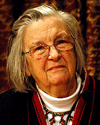
A General Framework for Analyzing Sustainability of Social-Ecological Systems
Elinor Ostrom
Abstract: In this presentation, I would first like to present an article recently published in Science entitled "A General Framework for Analyzing Sustainability of Social-Ecological Systems." After presenting an overview of the published article, I will go on to discuss some of our current efforts to develop this ontological framework still further.
Bio: Lin is the Arthur F. Bentley Professor of Political Science and Senior Research Director of the Workshop in Political Theory and Policy Analysis, Indiana University, Bloomington; and Founding Director, Center for the Study of Institutional Diversity, Arizona State University. She is a member of the American Academy of Arts and Sciences, the National Academy of Sciences, and the American Philosophical Society, and a recipient of the Reimar Lüst Award for International Scholarly and Cultural Exchange, the Elazar Distinguished Federalism Scholar Award, the Frank E. Seidman Distinguished Award in Political Economy, the Johan Skytte Prize in Political Science, the Atlas Economic Research Foundation’s Lifetime Achievement Award, and the John J. Carty Award for the Advancement of Science.
| 3:00 PM | Informatics East 130

SeerSuite: Enterprise Search and Cyberinfrastructure for Science and Academia
Lee Giles
Abstract: Cyberinfrastructure or e-science has become crucial in many areas of science as data access often defines scientific progress. Open source systems have greatly facilitated design and implementation and supporting cyberinfrastructure. However, there exists no open source integrated system for building an integrated search engine and digital library that focuses on all phases of information and knowledge extraction, such as citation extraction, automated indexing and ranking, chemical formulae search, table indexing, etc. We propose the open source SeerSuite architecture which is a modular, extensible system built on successful OS projects such as Lucene/Solr and discuss its uses in building enterprise search and cyberinfrastructure for the sciences and academia. We highlight application domains with examples from computer science, CiteSeerX, chemistry, ChemXSeer, and archaeology, ArchSeer. CiteSeerX, the successor to CiteSeer, currently offers or intends to offer some unique aspects of search not yet present in other scientific search services or engines, such as table, figure, algorithm and author search. In addition, CiteSeerX continuously crawls the web and author submissions and now has nearly 1.5 million documents, close to 30 million citations, a million authors and comparable database tables. It has nearly 1 million unique users with several million hits a day. In chemistry, the growth of data has been explosive and timely, and effective information and data access is critical. The ChemXSeer (funded by NSF Chemistry) system is a portal and search engine for academic researchers in environmental chemistry, which integrates the scientific literature with experimental, analytical and simulation datasets. ChemXSeer consists of information crawled from the web, manual submission of scientific documents and user submitted datasets, as well as scientific documents and metadata provided by major publishers. Information gathered from the web is publicly accessible whereas access to restricted resources such as user submitted data will be determined by those users. Thus, instead of being a fully open search engine and repository, ChemXSeer will be a hybrid one, limiting access to some resources. Because such enterprise systems require unique information extraction approaches, several different machine learning methods, such as conditional random fields, support vector machines, mutual information based feature selection, sequence mining, etc. are critical for performance. We draw lessons for other e-science and cyberinfrastructure systems in terms of design, implementation and research and discuss future directions and systems.
References:
[ChemXSeer]
[CiteSeerX]
[Solr]
| 6:00 PM | Wells Library 001
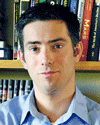
Collective mood analysis: measuring public sentiment from online resources
Johan Bollen
Abstract: Analysis of world-wide public sentiment has until recently mostly relied on large-scale surveys that ask individuals to rate their mood on a few dimensions of "happiness" or "satisfaction", e.g. the University of Michigan's World Values Surveys (WVS). In addition to painstakingly querying large numbers of individuals with regards to their mood, it has now become feasible to extract sentiment indicators from the texts that millions of individuals freely publish online. In the aggregate such indicators can reflect the collective mood as it is expressed online and as it varies in near real-time as new resources are continuously added to the web. In this talk I will provide an overview of this burgeoning domain, as well as our efforts to adapt existing psychometric instruments to assess multiple dimensions of the collective mood from large-scale collections of blogs and on tweets. Our research indicates that significant variations can occur in the collective mood over time and that we may be able to piece apart their various psychological components. Preliminary analysis suggests interesting relations between public mood and other economic and societal indicators.
Bio: Johan Bollen is associate professor at the Indiana University School of Informatics and Computing. He was formerly a staff scientist at the Los Alamos National Laboratory from 2005-2009, and an Assistant Professor at the Department of Computer Science of Old Dominion University from 2002 to 2005. He obtained his PhD in Experimental Psychology from the University of Brussels in 2001 on the subject of cognitive models of human hypertext navigation. He has taught courses on Data Mining, Information Retrieval and Digital Libraries. His research has been funded by the Andrew W. Mellon Foundation, National Science Foundation, Library of Congress, National Aeronautics and Space Administration and the Los Alamos National Laboratory. His present research interests are usage data mining, computational sociometrics, informetrics, and digital libraries. He has extensively published on these subjects as well as matters relating to adaptive information systems. He is presently the Principal Investigator of the NSF-funded MESUR project which aims to expand the quantitative tools available for the assessment of scholarly impact.
| 6:00 PM | Wells Library 001

Approximating the Geographical Characteristics of Internet Activity
Tony H. Grubesic
Abstract: Capturing the flow of information between cities is a challenging task. Historically, flow analyses have focused on goods, capital and people, all of which can serve as proxies for estimating the volume of spatial interaction between places. However, with the advent of the Internet and its ability to both facilitate and accelerate the exchange of information, it is somewhat surprising that so few studies have examined the geographical characteristics of Internet flows. Aside from the initial challenges associated in acquiring network flow data, there are additional constraints inhibiting such efforts, including privacy concerns, the geographic rectification of flows and the ability to manage and visualize massive datasets. The purpose of this paper is to outline a basic methodology for capturing Internet flow data and to provide a brief empirical analysis of these data for the Internet2 network in the United States. Results suggest that asymmetries exist between ingress and egress connectivity and flows throughout the U.S.
Bio: Tony Grubesic is an associate professor of Geography at the University of Indiana - Bloomington. He received his BA in Political Science from Willamette University, a MA in Geography from the University of Akron and a PhD in Geographic Information Science from the Ohio State University. For more details, including research interests and latest publications, see http://www.tonygrubesic.net.

Linked Justifications: Finding better Justifications from the Inference Web
Li Ding
Abstract: In distributed and linked environments like the Web, increasing statements were derived by the collaboration of distributed intelligent systems, and the statements can have alternative justifications some of which can be further decomposed into chains of distributed sub-justifications. While intensive research has been done on encoding justifications within different domains, work on linking and integrating the justifications is sparse. In this paper, we introduce a new concept "linked justifications" as a new type of linked data - data items are connected by derivation relations. We encoded the "linked justifications" using a directed hypergraph-based formalism and discusses the corresponding computations along with complexity analysis. We ran empirical evaluation on the formal proofs from the Thousands of Problems for Theorem Provers (TPTP) library (i) to illustrate the processes for constructing, linking and computing linked justifications from multiple sources, and (ii) to demonstrate its practical value by finding better justifications from proofs published on the Web.
Bio: Li Ding is a research scientist at the Tetherless World Constellation at Rensselaer Polytechnic Institute (RPI). As an early adopter of the Semantic Web (since 2000), his research interest covers many practical aspects of the Semantic Web, such as semantic web search, web-scale computing, ontology, provenance, privacy and trust, information integration, and social semantic web. He is the creator of Swoogle (swoogle.umbc.edu), the first practical semantic web search engine on the Web. He is an active researcher in Semantic Web community and has served as organizer and program committee member for major conferences such as WWW, ISWC, CIKM, and many other international workshops. He is a former Kodak postdoctoral fellow in the Knowledge Systems, Artificial Intelligence Laboratory (KSL) at Stanford University. He received Ph.D. in computer science from University of Maryland Baltimore County. Prior to that, he received B.S. and M.S. in computer science from Peking University.
| 4:00 PM | Wells Library 001

Abstract: Open your laptops and demo your software. Bring posters to introduce your research questions and results. Feel free to visit the IV/CNS Open House web site.
There will be demos of diverse tools and CIs between 4:15p - 5:45p.
Bio:
— Heather Roinestad: Demo
— Ruj Akavipat, Namrata Lele, Le-Shin Wu, Filippo Menczer: Demo of app & research.
— Joseph Cottam: Demo of Stencil: A Declarative, Generative System for Visualizing Dynamic Data
— Donna Drucker: 3 Posters of mid-twentieth-century network between Alfred Kinsey and Richard Goldschmidt
| 3:00 PM | Informatics East 130

Automated Visualization and Analysis Using the Grammar of Graphics Foundation
Leland Wilkinson
Abstract: Visualization has at least three purposes: 1) the inspection of raw data, 2) the assessment of assumptions underlying fitted models, 3) the presentation of fitted models. Automated visualization (AV) is an attempt to serve these purposes through intelligent automation of visualization and analytic methods. While AV might be designed to serve all three purposes equally well, its most suitable applications involve the early stages of a discovery process. AV, however sophisticated, should not replace the interactive process underlying the development and fitting of models themselves. It is best suited for discerning missing values, irregularities, anomalies, coding errors, and other effects that might bias the fitting of models or refinement of judgments based on data. The Grammar of Graphics is the title of a book and a framework for developing intelligent visualizations of statistical and scientific data. Joint work with Graham Wills, Dan Rope, and others has led to the implementation of a scalable visualization library based on the book. And joint work with Anushka Anand and Robert Grossman at UIC has led to the development of a novel algorithm (originally proposed by John Tukey) for detecting patterns in high-dimensional datasets. These ideas will be illustrated on real data through several different interactive software applications.
Bio: See http://en.wikipedia.org/wiki/Leland_Wilkinson
| 3:00 PM | IMU Persimmon Room

Modern Probability and statistical problems in real world networks
Shankar Bhamidi
| 6:00 PM | Wells Library 001

An overview of real-world public health informatics solutions that support public health practice
Shaun Grannis
Abstract: Clinical and public health arenas face similar challenges when considering the development of regional information exchanges. Health care information is scattered across many independent databases and systems as separate data islands with different patient and provider identifiers, concept identifiers, and location identifiers. This is true for data collected within an institution and for data collected about the same patient at different health care institutions or public health organizations. These pervasive realities create layers of complexity in health care information aggregation efforts for both public health and clinical care uses. On the public health front, the Centers for Disease Control (CDC) promotes specifications to ensure consistent public health information networks can serve the nation's public health information needs. Because public health initiatives must cross all of the separate silos and other facets of healthcare, public health and clinical medicine have shared interests in reusable data exchange systems. Public health is in fact part of the comprehensive health care ecology both from a patient care perspective and from a health care IT perspective. Data generated in typical clinical workflow, such as immunization records and reportable laboratory results, are just two examples of information having dual use in both clinical medicine and public health. Similarly, routinely collected point of care emergency department encounter data can be of great value to public health syndromic surveillance efforts. This talk will describe existing medical informatics solutions that support public health practice in Indiana, including syndromic surveillance and automated notifiable disease reporting.
Bio: Dr. Shaun Grannis is a Medical Informatics Researcher at the Regenstrief Institute, Inc. and Assistant Professor of Family Medicine at Indiana University School of Medicine, where his research interests include developing, implementing and studying technology to overcome the challenges of integrating data from distributed systems for use in health care delivery and research. Dr. Grannis developed a patient record linkage algorithm using cryptographically deidentified demographic data for use in distributed clinical data networks. The goal of the linkage algorithm is to maintain patient confidentiality while providing researchers with access to clinically meaningful data. He further extended and characterized this linkage methodology using robust probabilistic techniques.

Maps, Mission, Action
Allen Carroll
Abstract: For nearly a century, National Geographic's cartography has helped fulfill the Society's mission to inspire people to care about the planet. Always a powerful platform for storytelling, maps--now digitally-enabled--have new power to turn inspiration into action. A new Global Action Atlas will enable a worldwide audience of engaged citizens to discover and support hundreds of local projects seeking to tackle the great challenges of our time, including conservation, poverty, health, hunger, and climate change.
Bio: For more than a decade, Allen Carroll, chief cartographer of the National Geographic Society, has been deeply involved in the creation of the Society’s renowned reference and wall maps, globes, and atlases. He led the creation of the Seventh and Eighth editions of the World Atlas, incorporating satellite imagery and innovative thematic maps into the editions and integrating them for the first time with interactive Web resources. Carroll was instrumental in launching the National Geographic MapMachine, its first interactive atlas on the Web. He has spearheaded the publication of many new maps and Web resources, ranging from decorative wall maps and supplement maps for National Geographic magazine to special projects featuring biodiversity, conservation, and indigenous cultures. His map designs have won numerous awards, including best in show at the American Congress on Surveying and Mapping annual design competition. He advises the federal government as a member of the National Geospatial Advisory Committee.

From Analyzing to Forming Agent Networks for Sustainability
Arnim Wiek
Abstract: Studies of social networks and governance arrangements focus on analyzing frequency, intensity, density, quality, and other parameters of relations among agents. Departing from these approaches, agent network analysis and governance studies in sustainability science explicitly integrate a normative perspective into the research agenda. Critical questions are: How should agent networks be formed in order to promote and support endeavors towards sustainability? What roles and responsibilities need to be fulfilled by the agents involved in sustainability governance activities? The talk presents an analytical-normative concept for agent network analysis in sustainability studies and illustrates its application in empirical studies from Europe and the U.S.
Bio: Arnim Wiek is an Assistant Professor in the School of Sustainability at Arizona State University. He has conducted sustainability research on urban development, land use conflicts, and resource management in different European countries, Canada, USA, and Sri Lanka, as well as on sustainable governance of nanotechnology and nuclear power. His methodological research has focused on the collaboration between scientists and non-academic partners from government, business, and the civil society to support sustainability transitions. His current interest addresses the question how sustainability science can be developed as a genuine problem- and solution-oriented research field to make a substantial contribution to sustainability solutions. Prior to Arizona State University, he was a Visiting Scientist at the Institute for Resources, Environment, and Sustainability at the University of British Columbia. He holds a PhD in environmental sciences from the Swiss Federal Institute of Technology Zurich, a Master's degree in environmental sciences from the University of Jena, and a Master's degree in philosophy from the Free University Berlin.
| 6:00 PM | Wells Library 001

Predicting the behavior of techno-social systems: Planning for pandemic outbreaks in real time
Alessandro Vespignani
Abstract: We live in an increasingly interconnected world where infrastructures composed by different technological layers are interoperating with the social component that drives their use and development. Examples are provided by the Internet, the social Web, the new WiFi communication technologies and transportation and mobility infrastructures. The multi-scale nature and complexity of these networks are crucial features in the understanding of techno-social systems and the dynamical processes occurring on top of them. I will review the recent advances and challenge in this area and how we can look forward to new forecasting infrastructures in the context of techno-social systems. As a foremost example I will review the recent development and the major roadblocks in the computational approach to the prediction and control of emerging diseases. In particular I will discuss the global epidemic and mobility (GLEaM) computational platform and its use in the early stages of the recent H1N1 outbreak to provide real-time projections and scenarios on the unfolding of the epidemic.
See also his recent Science article on Predicting the Behavior of Techno-Social Systems.
Bio: Vespignani obtained his Ph.D. at the University of Rome "La Sapienza." After holding research positions at Yale University and Leiden University, he joined the condensed matter research group at the International Center for Theoretical Physics (UNESCO) in Trieste. Before joining IU, Vespignani was a member of the French National Council for Scientific Research carrying out research and teaching activities at the Laboratoire de Physique Theorique of the University of Paris-Sud. He has authored more than 100 scientific papers on the properties and characterization of non-equilibrium phenomena, critical phase transitions and complex systems. Recently Vespignani's research activity is focused on the interdisciplinary application of statistical physics and numerical simulation methods in the analysis of epidemic and spreading phenomena and the study of biological, social and technological networks.
| 6:00 PM | Wells Library 001

Abstract: An increasing fraction of human interactions are digitally captured. These digital breadcrumbs, combined with substantial computational power, create enormous opportunities for ground breaking science. This talk will discuss what some of the potential opportunities are for developing an improved understanding of collective human behavior, as well the potential barriers to the emergence of a "computational social science." In particular, the objective of this talk will be to spur discussion regarding how to bridge the gap between various methods for data mining and enhancing understanding of human behavior.
Bio: David Lazer is Director of the Program on Networked Governance at Harvard University, and Associate Professor of Public Policy. His research focuses on issues around the collective governance issues that arise when we think of network as a public good. He has examined this issue in many domains, from examining how agencies work together, to how interest groups are linked, to how teams work together. His research has been published in the top general scientific journals, as well as top journals in political science and organizational theory.
| 6:00 PM | Wells Library 001
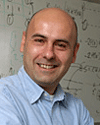
Optimal Transportation Networks
Alessandro Flammini
Abstract: Our current understanding of networks structure and evolution is largely based on the description of the dynamical processes that have shaped them. Alternative approaches based on principles of optimality have been proposed, but certainly are not mainstream. Although there are good reasons for that, I will discuss examples where such approaches are fruitful, focusing especially on the case of road networks.
Bio: Alessandro Flammini did his graduate studies at the Institute for Advanced Studies of Trieste, Italy, where he received a PhD in Condensed Matter Physics. After that, he spent 3 years as a postdoc, first at MIT, and then at the University of Cambridge, UK. He held senior research positions at ISAS Trieste and at the University of Lausanne Switzerland. He joined the School of Informatics at IU in August 2004. He is currently a member of the Center for Complex Networks and Systems Research. His research interests are generally in the area of complex networks, and in information and transportation networks in particular.
| 6:00 PM | Wells Library 001

Emergent Computation In Complex Network Dynamics
Luis Rocha and Manuel Marque-Pita
Abstract: Complex systems approaches to biological modeling often aim at the discovery of the "laws" of Biology. This endeavor entails a trade-off between generality and predictability. I argue that complex systems approaches, on their search for universal principles, have erred too much on the side of generality with very few examples of successful modeling of actual biological systems. In particular, we focus on the study of emergent computation in networks of automata. While there have been advances toward understanding the structure of natural networks, as well as some modeling of specific biological systems as networks of automata, it is still largely an open question how the dynamics of complex networks can lead to emergent, collective computation and how to control or "program" it to perform specific tasks. We discuss a new methodology based on Holland's schemata, for characterizing the dynamics of large automata networks, such as cellular automata and Boolean networks. We focus on examples from the systems biology literature, such as the segment polarity network of the Drosophila Melanogaster (21 nodes), and a large biochemical intracellular signal transduction network (139 nodes). We discuss how our approach is useful to characterize regulation, control, robustness, modularity and collective computation in networks of automata.
Bio: Luis M. Rocha is an Associate Professor and director of the Complex Systems graduate Program in Informatics, member of the Center for Complex Networks and Systems, and core faculty of the Cognitive Science Program, at the Indiana University, Bloomington, USA. He is also the director of the FLAD Computational Biology Collaboratorium and in the direction of the associated PhD program in Computational Biology at the Instituto Gulbenkian da Ciencia, Portugal. His research is on complex systems, computational biology, artificial life, embodied cognition and bio-inspired computing. He received his Ph.D in Systems Science in 1997 from the State University of New York at Binghamton. From 1998 to 2004 he was a permanent staff scientist at the Los Alamos National Laboratory; where he founded and led a Complex Systems Modeling Team during 1998-2002 and part of the Santa Fe Institute research community. He has organized major conferences in the field such as the Tenth International Conference on the Simulation and Synthesis of Living Systems (Alife X) and the Ninth European Conference on Artificial Life (ECAL 2007). He has published many articles in scientific and technology journals, and has been the recipient of several scholarships and awards. Details about his research and teaching are available on his web site: http://informatics.indiana.edu/rocha.
| 6:00 PM | Wells Library 001

Abstract: From its very beginning, the potential of extracting valuable knowledge from the Web has been quite evident. Web mining - i.e. the application of data mining techniques to extract knowledge from Web content, structure, and usage - is the collection of technologies to fulfill this potential. Interest in Web mining has grown rapidly in its short existence, both in the research and practitioner communities. This talk provides an overview of the accomplishments of the field - both in terms of technologies and applications - and outlines key future research directions.
Bio: Jaideep Srivastava is a professor at the University of Minnesota, where he has established and led a research laboratory which conducts research in the information and knowledge aspects of computing. He has supervised 26 Ph.D. dissertations and 53 M.S. theses, and authored or co-authored over 220 papers in refereed journals and conferences. Dr. Srivastava has served on the editorial boards of various journals, including IEEE TPDS, IEEE TKDE, and the VLDB journal. He has also served as Program and Conference Chair for a number of prominent conferences, especially in the area of data mining, and is on the Steering Committee for the PAKDD series of conferences. He has delivered a number of keynote addresses, plenary talks, and invited tutorials at major conferences. Dr. Srivastava has a very active interaction with the industry, in both consulting and executive roles. Specifically, during a 2-year sabbatical during 1999-2001, he lead a corporate data mining team at Amazon.com (www.amazon.com) and built a data analytics department at Yodlee (www.yodlee.com) from the ground up. More recently, he spent two years as the Chief Technology Officer for Persistent Systems (http://en.wikipedia.org/wiki/Persistent_Systems), where he built an R&D division and oversaw the redesign of the training and technical vitalization program for 2,200+ engineers. He has provided technology and technology strategy advice to a number of large corporations including Cargill, United Technologies, IBM, Honeywell, 3M, and Eaton. He has served in an advisory capacity to a number of small companies, including Lancet Software and Infobionics. Dr. Srivastava has also played an active advisory role in the government sector. Specifically, he has served as the US federal government's expert witness in a nationally significant tax case. He is presently serving as Senior Technology Advisor to the State of Minnesota, and is on the Technology Advisory Council to the Chief Minister of Maharashtra, India. He is a Fellow of the IEEE, and has been an IEEE Distinguished Visitor.
| 6:00 PM | Wells Library 001
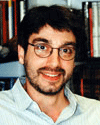
Complex Brain Networks
Olaf Sporns
Abstract: The human brain is a complex network. My talk will be about emerging links between the connectivity structure of the brain and its functional dynamics, and about how we might construct a computational network model of the brain. We now know that structural brain networks exhibit a number of topological features, including small-world attributes, modularity, and hubs. How do these structural features relate to functional characteristics of brain networks, to their dynamic patterns, to their processing power, robustness, or capacity to support flexible behavior? I will review recent work on complex brain networks that aims to identify how brain networks are organized and how they process and integrate information. I will also outline how these efforts may inform the design of a comprehensive structural and dynamic model of the human brain.
Reference: Bullmore, E.T, Sporns, O. (2009) Nature Reviews Neuroscience 10, 1-13.
Bio: Olaf Sporns received a Ph.D. in neuroscience from Rockefeller University (New York) and conducted postdoctoral work at The Neurosciences Institute in New York and San Diego. Currently he is Professor and Associate Chair in the Department of Psychological and Brain Sciences at Indiana University in Bloomington. His main research area is theoretical and computational neuroscience, with an emphasis on network complexity, brain connectivity, and neurorobotics. He serves on the editorial boards of several journals, including PLoS ONE, PLoS Computational Biology, and Neuroinformatics.
| 6:00 PM | Wells Library 001

Data + Art
Aaron Koblin
Abstract: Human senses are finely tuned to understand and evaluate visible and audible objects in a dynamic and interactive way. My talk will discuss a number of experiments and artworks that employ expressive interfaces to investigate data in compelling ways. The work will explore the concept of narrative through data visualization and the use of data as a medium for art. Specific works will range from more traditional visualizations of air traffic, cellphone networks, and wired telephony systems, to more abstract multi-media content collected from workers online, and laser range finders used for both understanding ecology, and making music videos.
Bio: Aaron Koblin is an Artist/Designer/Researcher focused on creating and visualizing human systems. Currently part of Google's Creative Lab in San Francisco, California, Aaron creates software and architectures to transform social and infrastructural data into rich digital expression. Koblin's work has been shown internationally and is part of the permanent collections at the Museum of Modern Art (MoMA) in New York.
| 6:00 PM | Wells Library 001

Network Workbench: Current and future development at the Cyberinfrastructure for Network Science Center
Micah Linnemeier
Abstract: The presentation will discuss the various projects of the Cyberinfrastructure for Network Science Center, demonstrating recent developments in the Network Workbench tool, as well as describing some of our future work: the EpiC and SciPolicy cyberinfrastructure projects.
Network Workbench helps network scientists process, analyze, and visualize network data. It is highly-extensible, allowing users to contribute their own algorithms to the tool, which are able to interact seemlessly with existing Network Workbench functionality. This flexibility is made possible by the CIShell cyberinfrastructure framework, which is the foundation of our upcoming cyberinfrastructure tools as well. New functionality in Network Workbench includes a collection of algorithms for handling weighted networks, and support for scientometrics analysis and processing.
The upcoming EpiC (short for Epidemics Cyberinfrastructure) project aims to create a tool to aid in the modeling, analysis, and visualization of epidemics data. The EpiC project is also developing a community website to facilitate the sharing of datasets in the epidemics community.
SciPolicy will expand the scientometrics functionality in Network Workbench into a separate full-fledged tool, making it easy for science policy makers to visualize and understand large sets of scientometrics data.
Bio: Micah Linnemeier is a senior systems architect and project manager at the Cyberinfrastructure for Network Science Center founded by Dr. Katy Börner. Linnemeier graduated from Indiana University with a B.S. in Computer Science in December 2007. His current projects include Network Workbench (nwb.slis.indiana.edu), SciPolicy, EpiC (epic.slis.indiana.edu), and Cyberinfrastructure Shell (www.cishell.org). His research interests comprise Software Engineering and Cyberinfrastructure development.
| 6:00 PM | Wells Library 001

Visual Data Mining of Multimedia Data for Social and Behavioral Studies
Chen Yu
Abstract: With advances in computing techniques, a large amount of high-resolution high-quality multimedia data (video and audio, etc.) has been collected in research laboratories in various scientific disciplines, particularly in cognitive and behavioral studies. How to automatically and effectively discover new knowledge from rich multimedia data poses a compelling challenge since most state-of-the-art data mining techniques can only search and extract pre-defined patterns or knowledge from complex heterogeneous data. In light of this challenge, we propose a hybrid approach that allows scientists to use data mining as a first pass, and then forms a closed loop of visual analysis of current results followed by more data mining work inspired by visualization, the results of which can be in turn visualized and lead to the next round of visual exploration and analysis. In this way, new insights and hypotheses gleaned from the raw data and the current level of analysis can contribute to further analysis. As a first step toward this goal, we implement a visualization system with three critical components: (1) A smooth interface between visualization and data mining; (2) A flexible tool to explore and query temporal data derived from raw multimedia data; and (3) A seamless interface between raw multimedia data and derived data. We have developed various ways to visualize both temporal correlations and statistics of multiple derived variables and as well as conditional and high-order statistics. Our visualization tool allows users to explore, compare, and analyze multi-stream derived variables and simultaneously switch to access raw multimedia data.
Bio: Chen Yu received a Ph.D. in computer science from University of Rochester in 2004 before he joined IUB. Currently he is an assistant professor in Department of Psychological and Brain Sciences, Cognitive Science Program and Department of Computer Science. His main research area is human cognition and learning using both computational and empirical approaches, with emphases on understanding both how language learning depends on coupled multimodal dynamics among brain, body and environment, and the underlying learning mechanisms that support statistical multimodal learning. His research is supported by NIH, NSF and NIJ. His lab’s website at http://www.indiana.edu/~dll/.

Food Webs From RNA Structures: The Emergence and Analysis of Complex Ecological Networks
George Kampis
Abstract: Understanding ecosystems is one of the most important challenges for theoretical biology and Artificial Life. We offer a bottom-up, fully individual-based model where phenotype-to-phenotype interactions of organisms define ecological networks and we study how simple conditions give rise to complex food webs if we allow for the evolution of phenotypes and hence phenotype interactions. A key element of the model is the notion of "rich phenotype" realized as a set of nonlinear tradeoffs in a multi-trait system. To approach this, we have chosen one of the best understood phenotypes, RNA structures, and assigned ecological functions to their features. In a series of experiments we show the emergence of complex food webs with generic properties, which indicates that minimalist assumptions such as having rich phenotype interactions might be sufficient to generate complex ecosytems and to explain some puzzling ecological features.
Bio: Founding chairman and Professor, since 1994, of the department of History and Philosophy of Science at Eötvös University in Budapest (http://hps.elte.hu). He holds a PhD and a Habilitation in Biology as well as a D.Sc. in Philosophy of Science. Main research interests in Artificial Life, cognitive science (Director of the Budapest Semester in Cognitive Science, http://hps.elte.hu/BSCS), complex systems and evolutionary modeling (www.evotech.hu), especially using agent based systems. He was guest professor at Hokkaido University (in 2001 and 2004), in 2002/3 he was Fujitsu Chair of Complex Systems at JAIST (Japan Advanced Institute for Science and Technology), and Wayne G. Basler Chair of Excellence at East Tennessee State University in 2007. Dr Kampis has of over 100 scientific publications, he is the author or editor of several books (with Pergamon, Kluwer, Springer etc.). He mastered several translations to Hungarian, among other things, The Origin of Species, and Darwin’s Dangerous Idea. His most recent research monograph “Feedback Self-Organization” will be published by Springer in 2010 (together with computer scientist Dr Laszlo Gulyas, http://user.aitia.ai/~gulyas_laszlo/). He is currently a fellow of Collegium Budapest (www.colbud.hu), member of the EC FP6 project QosCosGrid (www.coscosgrid.eu), project leader of the TexTrend project (www.textrend.hu), leader of the Comparative Mind Database module of the ESF Network CompCog (www.compcog.org) ,and Hungarian group leader of the upcoming FP7 project DynaNets. He is co-organizer, together with Professor Eörs Szathmary, of the upcoming European Conference on Artificial Life (ECAL2009, www.ecal2009.org). In the Spring of 2009, he is a Fulbright Scholar at Indiana University, Bloomington, at Cognitive Science/Complex Systems.
| 6:00 PM | Wells Library 001
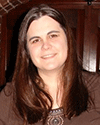
Co-Authorship Networks in the Mental Illness Recovery Research Movement
Ann McCranie
Abstract: The field of mental health services research incorporates researchers and practitioners from the fields such as psychology, psychiatry, social work, health policy, and consumer advocacy. This diverse field saw a marked increase in the publication of recovery-oriented literature and the development of recovery-oriented clinical and organizational practices starting in the mid 1980s and continuing to the present. In services research, the meaning of recovery in severe mental illness (SMI) is contested, but refers broadly to the idea that the long-term prospects of people with SMI need not be dire and illness-defined. Instead, the concept of recovery suggests the care of SMI should be person- and future-oriented and should allow individuals to work toward personally meaningful goals. While this may not seem to outsiders as much of a challenge to service providers, in the 1980s and beyond, recovery became a rallying cry for those who sought to contest overly custodial and pessimistic providers and systems of care. The recovery "movement" in the research literature appears to be what Frickel and Gross termed a scientific/intellectual movement (2005). This study expands the network argument of the SIM framework and examines the evolution of the recovery research network through co-authorship and past and present academic, clinical, disciplinary and other professional affiliations. Multiple types of approaches, including centrality, evolutionary models, and p* models are used to explore this scientific movement.
Bio: McCranie is a PhD candidate in the Department of Sociology at Indiana University Bloomington. Her research interests are in organizational studies, network analysis, and medical sociology. Her dissertation will be about institutional change in mental health care services in the United States, in particular the introduction of "recovery" based services for people with serious mental illness.
| 6:00 PM | Wells Library 001

Abstract: In all social and economic interactions, individuals or coalitions choose not only with whom to interact but how to interact, and over time both the structure (the "with whom'') and the strategy ("the how'') of interactions change. Our objectives here are to model the structure and strategy of interactions prevailing at any point in time as a directed network and to address the following open question in the theory of social and economic network formation: given the rules of network and coalition formation, the preferences of individuals over networks, the strategic behavior of coalitions in forming networks, and the trembles of nature, what network and coalitional dynamics are likely to emergence and persist. Our main contributions are (i) to formulate the problem of network and coalition formation as a dynamic, stochastic game, (ii) to show that this game possesses a stationary correlated equilibrium (in network and coalition formation strategies), (iii) to show that, together with the trembles of nature, this stationary correlated equilibrium determines an equilibrium Markov process of network and coalition formation which respects the rules of network and coalition formation and the preferences of individuals, and (iv) to show that, although uncountably many networks may form, this endogenous process of network and coalition formation possesses a nonempty finite set of ergodic measures and generates a finite, disjoint collection of nonempty subsets of networks and coalitions, each constituting a basin of attraction.
Bio: Professor Page’s current research interests lie in two areas: (1) strategic network formation and (2) competitive nonlinear pricing games. In the area of strategic network formation, his current work focuses on the emergence of stochastic network dynamics from strategic behavior and stochastic elements in nature. In the area of competitive nonlinear pricing games, his current work focuses on the Nash existence problem in such games. Professor Page has published in Econometrica, the Journal of Economic Theory, Economic Theory, the Journal of Mathematical Economics, the International Journal of Game Theory, the Journal of Financial and Quantitative Analysis, the Journal of Public Economic Theory, the Annals of Finance, the Journal of Economic Behavior and Organization, Canadian Mathematical Bulletin, Journal of Global Optimization, Optimization, Review of Economic Design, Social Choice and Welfare, Mathematical Social Sciences, and Economic Letters. Professor Page is an Associate Editor of the Journal of Public Economic Theory, the Annals of Finance, and Economics Bulletin. He is regularly Visiting Professor at the University of Paris 1 (Pantheon-Sorbonne) and he has twice (1996 and 2006) been the organizer of the NSF/NBER Decentralization Conference. He is Vice President of the Association for Public Economic Theory.

Mapping connections between the genome, ionome and the physical landscape
David Salt
Abstract: Understanding how organisms control their ionome or mineral nutrient and trace element composition, could have a significant impact on both plant and human health. Furthermore, associating the genetic determinants that underlie natural ionomics variation, with the landscape of the individuals that carry these genotypes, will provide insight into the genetic basis of adaptation and speciation. We have employed high-throughput mineral nutrient and trace element profiling, using inductively coupled plasma – mass spectrometry (ICP-MS), as a tool to determine the biological significance of connections between an organisms genome and its ionome. Our focus is on genes that control uptake and accumulation of mineral elements, including Ca, K, Mg, P (macronutrients in plant fertilizer), Co, Cu, Fe, Li, Mn, Mo, Ni, Se, Zn, (micronutrients of significance to plant and human health) and As, Cd, Na and Pb (elements causing agricultural or environmental problems). To date we have analyzed the ionome of over 100,000 Arabidopsis plants and 20,000 yeast samples. This includes several Arabidopsis forward genetic screens (Lahner et al., 2003 Nat. Biotechnol. 21:1215), a screen of 360 natural Arabidopsis accession, and a complete analysis of all 5153 strains of the yeast deletion collection (Danku et al., 2009 JAAS (in press)). We have successfully used PCR-based positional cloning, DNA microarray based approaches, QTL and association mapping to identify numerous genes that control the ionome (for example Rus et al., 2006 PLoS Genetics 2(12): e210; Baxter et al., 2008 PLoS Genetics 4(2):e1000004). Association of variation in these genes with the landscape in which these plants naturally grow is starting to reveal the genetic architecture underlying specific adaptations to the environment. We are also finding that specific ionomic “fingerprints” are associated with functionally related sets of genes, and also with the physiological status of the organism (Baxter et al., 2008 PNAS 105: 12081-12086). To maximize the value of this ionomics approach, we have developed a publicly searchable online database containing ionomic information on over 1000,000 samples from over 1500 different experiments (www.ionomicshub.org; Baxter et al., 2007 Plant Physiol 143: 600-611), and the database is being updated regularly.
| 4:00 PM | Swain Hall West 238

Information Flow Through Local Cortical Networks Is Not Democratic
John M. Beggs

Visualizing Social Networks to Discover Trends and Trendsetters
Peter Gloor
Abstract: This talk introduces Condor, a tool for dynamic semantic social network analysis, which has been developed for the last six years at the MIT Center for Collective Intelligence in collaboration with University of Cologne, Helsinki University of Technology and others. Condor includes a novel set of social network analysis based algorithms for mining the Web, blogs, and online forums to identify trends and find the people launching these new trends. Algorithms include the temporal computation of network centrality measures, the visualization of social networks as Cybermaps, a semantic process of mining and analyzing large amounts of text based on social network analysis, and sentiment analysis and information filtering methods. The temporal calculation of betweenness of concepts permits to extract and predict long-term trends on the popularity of relevant concepts such as brands, movies, and politicians. Among other examples, our approach will be illustrated by qualitatively comparing Web buzz and Web betweenness for the 2008 US presidential elections, as well as correlating the Web buzz index with share prices. See also: http://www.ickn.org.
Bio: Peter A. Gloor is a Research Scientist at the Center for Collective Intelligence at MIT's Sloan School of Management where he leads a project exploring Collaborative Innovation Networks (www.ickn.org). He also teaches at the University of Cologne and Helsinki University of Technology and is Chief Creative Officer of startup galaxyadvisors. Until the end of 2002, Peter was a Partner and European e-Business Practice leader with Deloitte Consulting, a Partner with PricewaterhouseCoopers and Section Leader for Software Engineering at UBS. He received his Ph.D. in Computer Science from the University of Zurich in 1989. His two most recent books are "Coolhunting - Chasing Down The Next Big Thing", Amacom 2007 (with Scott Cooper) and "Swarm Creativity – Competitive Advantage through Collaborative Innovation Networks", Oxford University Press, 2006. Peter blogs at swarmcreativity.blogspot.com.





